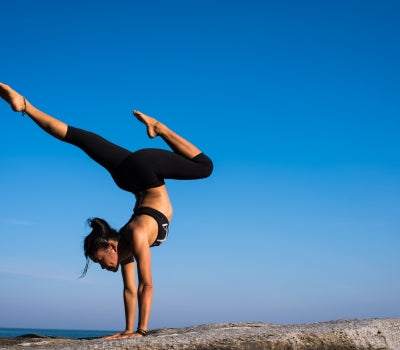This post comes from the blog over at Carmichael Training systems. We recently partnered with them to share knowledge and provide FLUID Recovery for their athletes and training camps. If you’re in need of top-level coaching for any sport, we definitely recommend checking them out.
By Mara Abbott
Olympian and CTS Contributing Editor
I promise you this: yoga will change you as an athlete and it will change you for the better. Practicing regularly will increase both your athletic potential and longevity, and it will do so regardless of whether or not you can do the splits, or stand on your head, or balance on one hand with both feet curled behind you. The strength of a yoga practice is derived from consistency and quality. If you only have five or ten minutes a day for yoga but you take that time to fully experience the sensations of your movement, it will benefit you far more than a two-hour advanced workshop on a Sunday afternoon spent thinking about the laundry you need to do when you get home and how the girl next to you has cool stretchy pants.
While racing professionally, I took four different yoga teacher trainings. I traveled with a mat in my carry-on and used it in corners of airports around the world, in abandoned stairwells, basements and meeting rooms of European hotels. I turned myself to face the wall and took my contacts out, assuming that if I couldn’t see other people while acting like a lunatic, they couldn’t see me doing it either.
I used my mat to pad my bike in its case during travel, covered it with grease and dirt and crumbs, wore holes straight through it from overuse and had to buy a new one. I have no doubt that the trajectory of my cycling career would have been very different without my yoga practice and I am also quite certain that its influence had nothing to do with whether I could touch my toes – because I can’t.
I could list my five favorite poses for endurance athletes, and give you tips and cues to work on. I will do that, eventually, but the “what” of a yoga practice for athletes is far less important than the “why”, or the “how”, or the “who” (the “where” and “when” are up to you). If you want to stretch, go stretch. Hit those quads and hips and you’ll do yourself some good – but a deeper exploration of yoga offers so much more.
***
Get to know your body
When you move through a yoga practice slowly, paying attention to how each posture feels, you will notice variations from day to day and from side to side. You will learn which is the tight hip and which knee is sore for kneeling. Transitioning between postures, you will notice catches and hiccups from weakness or fatigue, and your favorite poses will feel different after a hard workout.
Increased physical self-knowledge gives you a leg up on preventing injuries (or halfway up, if you have tight hammies), but more than that, I think it is also incredibly important to simply understand and honor the machine. Off the front, up a climb alone, I was always so happy to have an intimate knowledge of what my legs felt like under exertion, to have honed an instinct for when I could press on and when I needed to hold back. The time on my mat strengthened that mind-body communication pathway in an environment where I could be a bit more emotionally receptive than I generally find myself in the middle of an interval workout or when I’m surrounded by a hundred other win-hungry girls on bikes.
Give up control.
When you roll out a mat in a yoga studio, you are placing your trust in your teacher to curate your experience for the next hour. The forced exposure to new movement patterns and postures is one of the reasons I advocate taking public classes when possible, at least every so often, instead of doing your personal favorite sequence again and again in your living room. As a competitive athlete who was highly protective of my physical and emotional experience, I found it incredibly challenging to cede control or try new things – and that is why it was so critically important. If you go to class, trust your teacher, are willing to fall, and are willing to flail, then you will have the opportunity to practice reacting when the world reveals itself to be more complex than you imagined. To succeed, in bike racing in particular, requires a constant ability to reboot your entire mental concept of a situation as circumstances change. Those who cannot do this will only win on the days that everything happens as predicted. Those days are rare – in competition and in life.
I would therefore encourage you to find an instructor you trust and can form a relationship with. It’s possible to stream classes now from a variety of sources, and this is an excellent economical option, but it’s easier to take yourself out of your comfort zone when you are face to face with other human beings. My tips: teachers who use adjustments to push you into poses where you are uncomfortable, who don’t offer modifications to make the practice accessible to all practitioners, and who have you in challenging, Instagram-worthy poses within five minutes of beginning a class are not necessarily the ones to trust. Also, leaving your comfort zone does not mean stretching further and holding longer – it means embracing the unknown and the awkward and being willing to sit with that.
Give up on perfection.
Competitive sports and perfectionism will always follow one another – frequently the work ethic associated with perfectionism helps forge great athletes and superlative performances. The problem is that perfectionism is a trait rarely meted out in reasonable doses. Endurance athletes, with our tight muscles, asymmetries, and our drive to achieve, are uniquely unsuited for fluid bending, balancing, and stillness. Showing up to a yoga class requires humility and a willingness for lighthearted experimentation – as one of my teachers often says, an advanced sense of humor is a prerequisite for an advanced yoga practice.
Yoga postures are about an experience rather than an endpoint. Even the most advanced posture is built of krama, or stages of evolution, from simple to complex. Each krama contains the same physical and mental benefits for each unique level of practitioner. Your level will change, up and down, across days and across phases of life. In yoga, you are forced to meet yourself every day exactly where you are – and you try not to judge that place, wherever it might be. Yoga teaches process, not outcome. For myself, this is a reminder I need at least once a day.
Sit with discomfort.
There are lots of parts of training and competition that are uncomfortable, but often that pain comes with so much additional stimulation we don’t actually witness our reaction to the challenge. Is it to dissociate? To push harder? To use past anger or past accomplishments as a motivator? Is it to give up? Yoga offers a gentle space that encourages impartial curiosity to explore those reactions.
When you hold a yoga posture and start to notice your arms and your legs fatiguing, you are silent, in a confined space, with yourself and your thoughts. With nothing to distract you from what is happening in your body and your brain, you have a chance to genuinely experience fear, panic, desperation, and the instant and unavoidable need to take a bathroom break – and you also have the chance to notice how you are employing those emotions to defend yourself from facing a limit. If you drop your hands or leave the room, the grass will continue to grow and no one will remember – but gaining familiarity with the strength and tendencies of your own stay-or-run reflexes will have an impact beyond your practice of sun salutations.
For myself, I actually find restorative classes to be the most challenging. My teacher, Shannon Paige, has been one of my most trusted allies throughout my adulthood (she was even the first person to hear the news when I found out I was going to the Olympics!), but on the very rare occasions when I have taken the risk to attend one of her Anjali Restorative classes, I have discovered that laying still, being quiet, and being told soothing and positive things about myself will very reliably spark a panic attack. The prospect of doing restorative yoga is genuinely terrifying to me, but as it requires me to face the emotions and thoughts I have made a career out of suppressing, I also know it is exactly where I need to be and it is something I cannot – or will not – do on my own.
Breathe.
I do not know if there is any reputable, researched data showing that working to control and lengthen breath on a regular basis yields any real cardiovascular benefits under exertion. I don’t actually care, because the breathwork of yoga, of learning to calm emotions and fear by consciously passing oxygen through the lungs, works regardless. Sometimes, the sensation that we cannot push any harder and that we cannot get enough air is a legitimate physiological limit, but other times it is a panicked reaction to a competitor’s attack or a brand-new self-imposed level of exertion. Learning to work with your breath will allow you to distinguish between the two – meaning sometimes, one deep inhalation is all you need to keep going.
One of the elements of pranayama, or controlled breathwork, is the practice of holding your lungs completely empty after an exhale or completely full after an inhale for several seconds. This often sparks reactions in practitioners. Depending on your disposition, you may find it more difficult to sit and feel yourself completely empty, ready for the new and unknown to flow in, or you may be more challenged by truly letting yourself feel full and complete. Both of those are something to understand and work with.
As athletes, we gain an edge through enhanced self-knowledge. Air is important in cardiovascular pursuits – so is it funny that most of us don’t have a solid grasp on what it feels like to just breathe?
***
In 2010 the ten-day Tour de l’Aude began with a four-kilometer prologue. I was racing with the US National Team, and we had dreams of making the final podium with my climbing legs. I finished that prologue, however, in the bottom quarter of the field – nearly forty seconds behind the winner in a race that took less than five minutes. I let Coach Dean know, over a very shaky Skype connection, that I was quite certain that the entire world was about to find out I was a fraud, and that the game was up on my limited cycling potential.
“Well,” Dean replied, proving that although a reliable skeptic, he actually understood my hippie mumbo-jumbo better than I did myself, “I guess now’s when you’ve got to use that yoga bullshit.”
I was lucky I had it to use, and lucky I had someone to remind me of it. Cowed by Dean’s astute observation, I took a deep breath and moved forward. With the support of my teammates, I won a stage and finished second overall.



